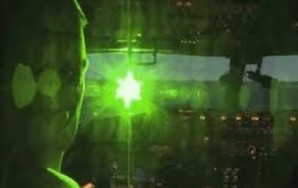

The FBI is warning that aiming laser pointers at flying aircraft poses a threat to pilots and law enforcement officials, because it could blind them and cause eye damage!
A laser, when aimed at an aircraft, can create a visual distraction or cause discomfort or even damage to a pilot’s eyes. The same applies to drivers of vehicles…
The term laser stands for “Light Amplification byStimulated Emission of Radiation”. Lasers are designed in various wavelengths and powers, and they are classified according to the type and the amount of damage they can cause to living tissue.
How pervasive is this problem of laser attacks?
Just to give you an idea – more than 2,800 laser incidents involving aircraft were reported in 2010 to the Federal Aviation Authority.
The problem of lasers being shined into cockpits is so prevalent and widespread in some areas of the country that the Federal Bureau of Investigation (FBI), the Federal Aviation Administration (FAA), the Federal Air Marshal Service, as well as State and local law enforcement, have established a “Laser Strike Working Group” to address the problem.
“The inappropriate use of widely available laser pointers against airborne flight crews represents a genuine and growing safety and security concern. At a minimum, the laser illumination of a cockpit creates a flight crew distraction and in more serious cases can result in eye damage and temporary incapacitation” said one pilot in Charlotte, N.C. who wished not to be identified in this story.
NOTE: The term `laser pointer’ means any device designed or used to amplify electromagnetic radiation by stimulated emission that emits a beam designed to be used by the operator as a pointer or highlighter to indicate, mark, or identify a specific position, place, item, or object.
“The FBI does not see this, these types of instances, as a harmless prank,” said Dean Bryant, acting special agent in charge of the FBI’s Norfolk field office. “We see these situations as criminal acts and we will deal with them as such. They’re serious, they’re reckless and they endanger the lives of innocent civilians.” On January 26th 2012 – A Virginia Beach man pleaded guilty in federal court on Wednesday to interfering with someone operating an aircraft after he acknowledged shining a green laser at a police helicopter as it searched for a fleeing suspect. The man could face 20 years in prison for targeting the police helicopter.
Green laser are a particular problem for police –
See You tube video: http://www.youtube.com/watch?v=nUpmLbkzyEI
Increasingly law enforcement should be aware of the use of lasers by terrorists and criminals. One police officer I spoke with (who declined to be named in this report) who is assigned to the helicopter crew says that “Green lasers is a concern for us during patrol. Especially when we are conducting surveillance or tracking a suspect.
Lasing incidents are not limited to aircraft. A laser show accident at an outdoor rave in Moscow resulted in eye injuries to dozens of attendees…Chris Baldwin, “Ravers Lose Sight at Laser Show,” Reuters, July 14, 2008, http://www.reuters.com/article/healthNews/idUSL1452972520080714 (accessed January 7, 2009).
Other incidents have involved fire trucks, buses, and sporting events. Fortunately, slowing and stopping ground vehicles is one possible recourse to laser-induced visual impairment—unlike with aircraft.
What to do when under a laser light attack:
For any laser event, pilots, drivers of vehicles, police , law enforcement should immediately close their eyes or move out of the line of sight to avoid further exposure.
Closing one eye allows continued visual function while protecting the closed eye from exposure.
If vision is compromised from an afterimage on the central retina, strategies such as eccentric, or “indirect, viewing “ are helpful.
By operating with peripheral (side) vision and using scanning movements of the eyes, no objects in the direction of travel are obscured by any blind spots.
Unfortunately, the sharpness of vision decreases exponentially as the distance between the center of the retina and the part of it used for vision increases. Instruments can be extremely difficult to read under such conditions.
“Afterimages” or “blind spots” occupy a fixed amount of space in a person’s field of vision. While a blind spot persists, objects located in that spot may be undetected. As an object comes nearer to the observer, however, the object projects an increasingly larger image on the observer’s retina, to the point that the image eventually exceeds the affected area and overlaps onto a functioning area.
Retinal afterimages, according to experts can last several seconds to several minutes before vision returns, whereas a retinal lesion—true damage to ocular tissues—may not ever return to normal function.
